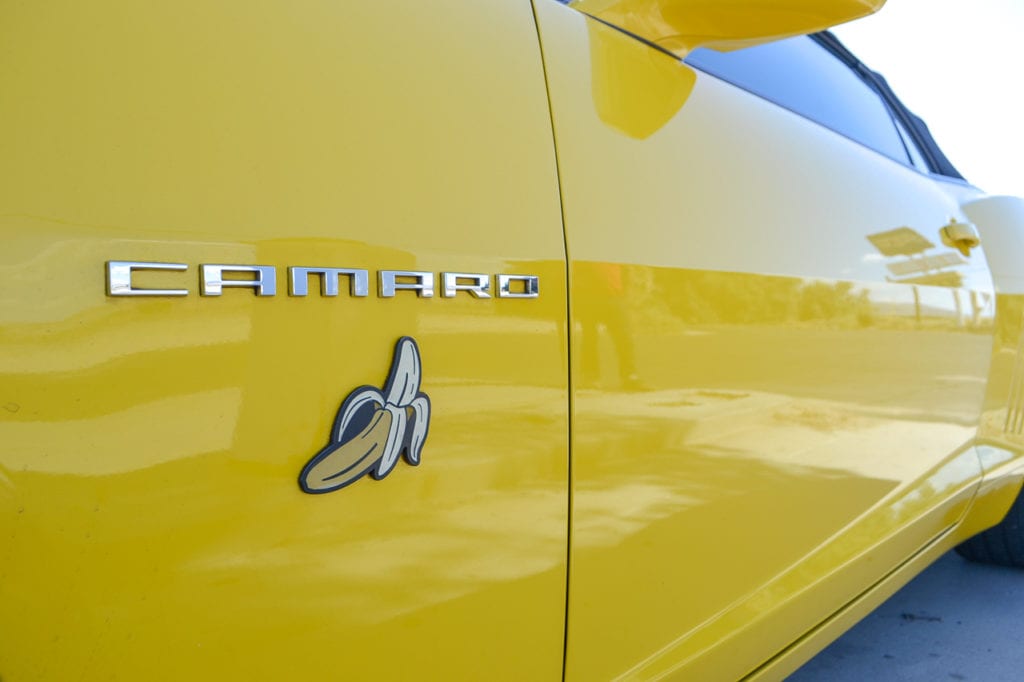The front door opens and a family steps inside. Two women, a toddler, and a baby. It takes a moment for their eyes to adjust. Outside, it’s a relatively mild desert spring day: 87 degrees and not a cloud in the sky. Inside, it’s tropical—but it has nothing to do with the weather. Instead, the small, dimly lit room is bursting with tropical fruit—and one yellow, bendy one in particular.
We’re talking banana phones, banana pens, banana-shaped bookends, stuffed bananas, banana clocks, banana napkin holders, palm trees with banana-eating monkeys hanging from them, a banana jukebox—name an item, and there’s a banana-themed version of it here. There’s even a banana-shaped turntable. It’s perpetually playing Kasso’s “I love the piano”—released on ‘80s Italo disco label Banana Records.
The newly arrived family members all have the same look on their faces—part confusion, part wonder—as the man behind the counter greets them with a smile: “Welcome to the Banana Museum. Go bananas!”


An unlikely location
A museum dedicated to bananas would be a strange sight in any setting. Where it sits now, though, the International Banana Museum really makes no sense at all. We’re on the northeastern shore of the Salton Sea, a toxic, 340-square-mile lake in the middle of the California desert. In the 1950s and ‘60s, this area was a thriving resort paradise. Vacationgoers would travel to the desert to swim, waterski, and play golf. Today, the area surrounding the sea is largely abandoned, and rotting fish lines its shores.
“A lot of people have a picture painted in their minds that it’s this toxic wasteland out here, but they really have no idea until they get out here to see the real beauty,” says Fred Garbutt. He’s the man behind the counter and the owner, together with his wife Kym, of the Banana Museum.
And he’s right—once you get used to the putrid smell emanating off the lake, this is a beautiful area, unlike any other place I’ve ever been to. The sea itself is muted, pastel-colored, and looks like a drawing out of a storybook. Deserted, sandy beaches surround it. At sunset, the sky is painted using all shades of the palette.

The average temperature in the area is 90 degrees. In the summer, it can hit 120 during the day. So why would anyone open a Banana Museum out here?
For Garbutt, the answer is mostly circumstance.
His family has owned the bar-turned-museum and the liquor store next door, along with the nine acres of property the building sits on, since 1959. He was looking for something to do with the space.
“Nine years ago, some guy was selling his world-record collection of banana stuff and I thought that would make a great tourist attraction,” he says. The original collection came with 17,000 banana-related items. Garbutt estimates that the current count is somewhere around 25,000—and it’s still growing.
-
Banana items on display. | Photo: Sanna Boman -
A banana-shaped turntable. | Photo: Sanna Boman -
More banana items on display. | Photo: Sanna Boman -
Banana buttons. | Photo: Sanna Boman -
Every inch of the museum is covered in yellow. | Photo: Sanna Boman
“I’ve run out of space,” he says. “In my collection, I have probably another 10 or 12 boxes of banana stuff that I don’t have room to put out yet.”
When he first opened the museum, Garbutt says he expected to “play second fiddle to Salvation Mountain.” The bizarre—and highly popular—art installation is a 40-minute drive south from the Banana Museum, along the Salton Sea’s eastern shore. But to his surprise, people started showing up asking, “What else is there to do out here?”
“They came just to see the Banana Museum!” he beams.
Banana-flavored treats
Garbutt’s yellow Chevrolet Camaro SS is parked out front. It has banana decals on the sides, a banana sunshade, and a license plate that reads “SS BNARO.” He used to drive a yellow bug, but has since upgraded. “If I’m going to go full banana, why not have a ‘Banaro?’” he says.
If it wasn’t for the bright yellow car marking the spot, the museum would be easy to miss. The building is small and nondescript. There’s really nothing else around.
-
Garbutt’s yellow Camaro, or “Banaro.” | Photo: Sanna Boman -
Garbutt’s yellow Camaro, or “Banaro.” | Photo: Sanna Boman -
Garbutt’s yellow Camaro, or “Banaro.” | Photo: Sanna Boman
The actual museum is just one room. When you first step inside, there’s a counter straight ahead, with a mirror behind it. Every available surface in the room is packed with banana-related items—from the bar stools at the counter to the pen visitors use to sign the guestbook with. Despite the dim lighting and covered windows, the place somehow doesn’t feel too dark. The pure onslaught of yellow helps.
It does get busy, though. During the hour or so I spend at the museum, a steady stream of visitors trickle in and out—mostly families out on a day trip from Palm Springs, which is only an hour away. Almost everyone buys something to eat. Garbutt makes his own banana-flavored ice cream, a visitor favorite alongside frozen chocolate-dipped bananas and his “world-famous” banana milkshake. “Everybody goes nuts over my banana treats,” he says.

If he ever expands, Garbutt says he’d like to install a proper kitchen, plus more tables and booths. Theoretically, adding on to the building would be easy. “It would be no problem because I have nine acres,” he says. But it all depends on what will happen with the lake, its omnipresence in the area impossible to ignore.
“If they have a long-term restoration project with the sea, some kind of future down the road where it’s going to [increase] how many people come down here, then yes, I would like to expand,” Garbutt says. He already has enough banana items to fill a much bigger space.

For now, Garbutt and his wife are happy to keep welcoming visitors into their popular, albeit tiny, destination. “It’s really fun to watch the smiles that people have, and it’s such a positive place,” he says.
Garbutt didn’t really have a personal connection to bananas before coming across the collection for sale. When asked how he feels about them now, he laughs and says: “They’re great. They’ve been very good to me.”
If you go
The International Banana Museum is (usually) open Friday through Monday, 1 p.m. to 5 p.m. It’s recommended to call ahead to make sure it’s open. Entrance is $1.














